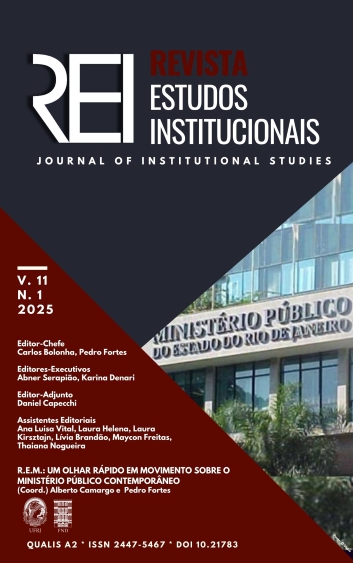DECONSTRUCTED REALITY, TANGIBLE HARM
FROM ONLINE FAKE NEWS TO GENOCIDE
DOI:
https://doi.org/10.21783/rei.v11i1.892Keywords:
International Criminal Law, Incitement to Genocide, Online Fake News, Computational PropagandaAbstract
This paper studies the historical development of the international crime of incitement to genocide, from its origins in Nuremberg to its contemporary online format, identifying the role of the media and fake news in it. Showing this progression and describing its underlying patterns is a research effort for legally interpreting a phenomenon. After identifying the elements of the crime according to international law and presenting the new aspects brought by cybercommunications, the paper analyses the Myanmar case to demonstrate how the existing legal framework may be applied to social media posts spreading fake news. Lastly, concerning speeches falling outside the scope of the norm, the paper proposes a new crime prohibiting the conduct of systematically creating or distributing fake news online when such conduct constitutes computational propaganda with the intent to harm groups protected under the Genocide Convention and assesses the democratic justification of the proposal.
Downloads
References
Agreement for the prosecution and punishment of the major war criminals of the European Axis (adopted 8 August 1945) 82 UNTS 279.
Application of the Convention on the Prevention and Punishment of the Crime of Genocide (The Gambia v Myanmar) (Request for the Indication of Provisional Measures: Order) General List No 178 [2020] ICJ.
Arendt H, Origins of Totalitarianism (2nd edn, Meridian Book 1958).
Benesch S, ‘Vile Crime or Inalienable Right: Defining Incitement to Genocide’ (2008) 48 VaJIntlL 485.
Bradshaw S and others, ‘Country Case Studies Industrialized Disinformation: 2020 Global Inventory of Organized Social Media Manipulation’ (2021) Oxford Computational Propaganda Research Project <https://medleysites.oii.ox.ac.uk/demtech/wp-content/uploads/sites/127/2021/03/Case-Studies_FINAL.pdf> accessed 5 December 2022.
Citarella J, ‘There’s a New Tactic for Exposing You to Radical Content Online: The “Slow Red-Pill”’ The Guardian (15 July 2021) accessed 5 December 2022.
Convention on the Prevention and Punishment of the Crime of Genocide (adopted 9 December 1948, entered into force 12 January 1951) 78 UNTS 277.
Draft Convention on the Crime of Genocide (26 June 1947) UN Doc E/477.
Eastwood M, ‘The Emergence of Incitement to Genocide Within the Nuremberg Trial Process: The Case of Julius Streicher’ (PhD thesis, University of Central Lancashire 2006) https://ethos.bl.uk/OrderDetails.do?uin=uk.bl.ethos.438233 accessed 5 December 2022.
Facebook, ‘An Update on the Situation in Myanmar’ (11 February 2021) https://about.fb.com/news/2021/02/an-update-on-myanmar accessed 5 December 2022.
Facebook, ‘Removing Myanmar Military Officials From Facebook’ (28 August 2018) https://about.fb.com/news/2018/08/removing-myanmar-officials/ accessed 5 December 2022.
Fiss O, The Irony of Free Speech (Harvard University Press 1996).
International Covenant on Civil and Political Rights (adopted 16 December 1966, entered into force 23 March 1976) 999 UNTS 171.
Lippman M, 'The Drafting of the 1948 Convention on the Prevention and Punishment of the Crime of Genocide' (1985) 3 BostonUIntlLJ 1.
Media Case (Appeals Judgment) ICTR-99-52-A, A Ch (28 November 2007).
Media Case (Judgment) ICTR-99-52-T, T Ch I (3 December 2003).
Perrigo B, ‘Facebook’s Ban of Myanmar’s Military Will Be a Test of the True Power of Social Media Platforms’ Time (1 March 2021) https://time.com/5943151/facebook-myanmar-military-ban/ accessed 5 December 2022.
Progressive Voice and others, ‘Hate Speech Ignited: Understanding Hate Speech in Myanmar’ (8 October 2020) Joint Report <https://hrp.law.harvard.edu/wp-content/uploads/2020/10/20201007-PV-Hate-Speech-Book-V-1.4-Web-ready1.pdf> accessed 5 December 2022.
Prosecutor v Akayesu (Judgment) ICTR-96-4-T, T Ch I (2 September 1998).
Rome Statute of the International Criminal Court (adopted 17 July 1998, entered into force 1 July 2002) 2187 UNTS 3.
Schabas W, Genocide in International Law: The Crime of Crimes (2nd edn, CUP 2009).
Stecklow S, ‘Why Facebook Is Losing the War on Hate Speech in Myanmar’ Reuters (15 August 2018) accessed 5 December 2022.
Timmermann W, ‘The Relationship Between Hate Propaganda and Incitement to Genocide: A New Trend in International Law Towards Criminalization of Hate Propaganda?’ (2005) 18 LJIL 257.
UNGA, ‘Report of the Independent International Fact-Finding Mission on Myanmar’ (12 September 2018) UN Doc A/HRC/39/64.
UNHRC, ‘Report of the Detailed Findings of the Independent International Fact-Finding Mission on Myanmar’ (17 September 2018) UN Doc A/HRC/39/CRP.2.
UNSC Res 955 (8 November 1994) UN Doc S/RES/955.
Wilson R, ‘Inciting Genocide with Words’ (2015) 36 MichJIntlL 277.
Woolley S and Howard P, ‘Introduction: Computational Propaganda Worldwide’ in Woolley S and Howard P (eds), Computational Propaganda: Political Parties, Politicians, and Political Manipulation on Social Media (OUP 2019).
Woolley S and Howard P, ‘Conclusion: Political Parties, Politicians, and Computational Propaganda’ in Woolley S and Howard P (eds), Computational Propaganda: Political Parties, Politicians, and Political Manipulation on Social Media (OUP 2019).
Downloads
Published
How to Cite
Issue
Section
License
Copyright (c) 2025 Bárbara Luiza Coutinho do Nascimento

This work is licensed under a Creative Commons Attribution-NonCommercial 4.0 International License.
The authors hold their copyright and concede to the JOURNAL OF INSTITUTIONAL STUDIES the right to the first publication, in accordance with the Creative Commons Attribution license.
Authors are strongly encouraged to publish their manuscripts in other medias, such as institutional repositories and personal pages. The Journal only requires the credits of the first publication.






